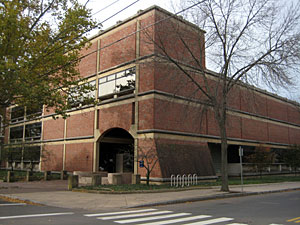A dustup over Yale University’s expansion plans has pitted alumni architects against one another.
Robert A.M. Stern, the dean of the Yale School of Architecture, from which he graduated in 1965, is designing two new residential colleges for the Ivy League institution’s campus in New Haven, Connecticut. Yale hasn’t added any new dorms since the early 1960s.

Seeley G. Mudd Library (1982), designed by Roth and Moore, is slated for demolition.
But the intended site for the Gothic-style buildings, which will total 460,000 square feet, is a 6.2-acre parcel on the campus¹s northwestern edge that until recently comprised classrooms, offices, and apartments. Of the 13 buildings on the site, which vary in age, one had been demolished by mid-October, and the others were empty and boarded-up. The school plans to raze most of the buildings within the next few months, despite pleas for preservation.
Among those targeted is the Seeley G. Mudd Library (1982), a four-story brick-and-concrete facility designed by Harold Roth, FAIA, and William Moore, AIA, both of whom earned M.Arch degrees from Yale and have an office up the street. This summer, after learning of Yale’s demolition plans, Roth and other critics met with Stern, though they couldn’t convince him to incorporate any of the existing buildings, including Mudd, into his scheme, they said.
“Bob Stern is a talented architect, and I’m sure whatever he does will be wonderful. But does it require a wholesale bulldozing?” says Moore, adding that saving the buildings would mesh with Yale’s stated eco-friendly mission. Mudd Library’s boxy rooms could nicely lend themselves to a music rehearsal spaces, Moore says. And next door, Hammond Hall, a Beaux-Arts structure with a wide-open layout, could easily accommodate a theater, he adds.
For his part, Stern referred all questions to Yale, which says construction on the $600 million project will continue despite the opposition. In a recent article in the Yale Daily News, Michael Morand, an associate Yale vice president, was quoted as saying: “No institution can survive and thrive if it chooses to remain frozen in time, and not every single structure ever built is a worthy candidate for preservation forever.” Construction is slated to begin in 2011.




Post a comment to this article
Report Abusive Comment